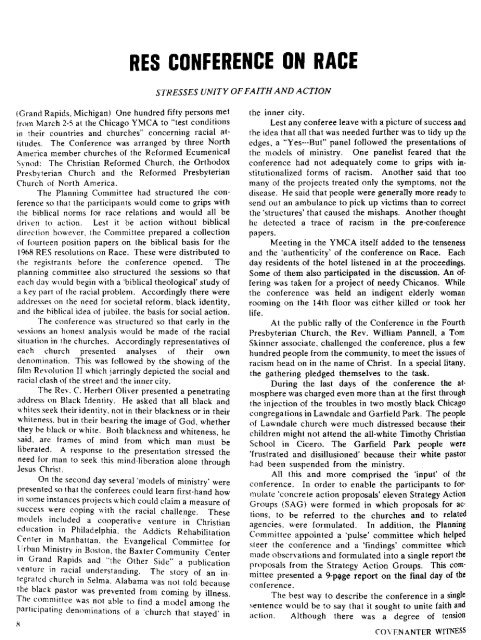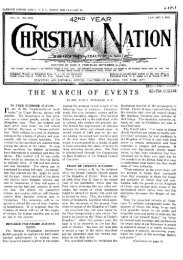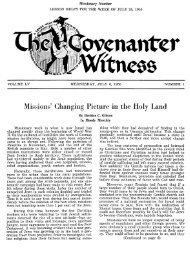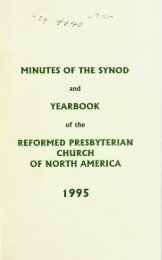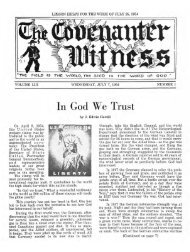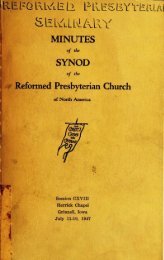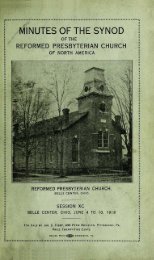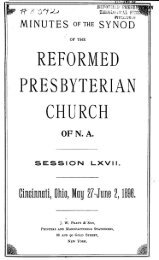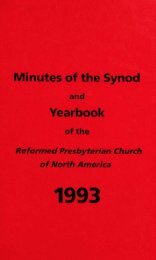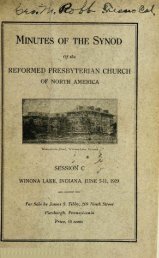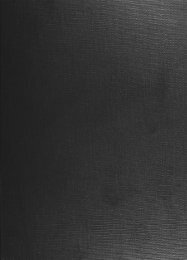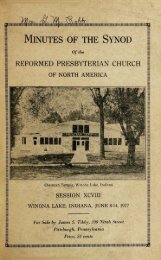Covenanter Witness Vol. 86 - Rparchives.org
Covenanter Witness Vol. 86 - Rparchives.org
Covenanter Witness Vol. 86 - Rparchives.org
You also want an ePaper? Increase the reach of your titles
YUMPU automatically turns print PDFs into web optimized ePapers that Google loves.
RES CONFERENCE ON RACESTRESSES UNITY OF FAITH ANDACTION(Grand Rapids, Michigan) One hundred fifty persons metfrom March 2-5 at the Chicago YMCA to "test conditionsin their countries and churches" concerning racial attitudes.The Conference was arranged by three NorthAmerica member churches of the Reformed EcumenicalSynod: The Christian Reformed Church, the OrthodoxPresbyterian Church and the Reformed PresbyterianChurch of North America.The Planning Committee had structured the conferenceso that the participants would come to grips withthe biblical norms for race relations and would all bedriven to action. Lest it be action without biblicaldirection however, the Committee prepared a collectionof fourteen position papers on the biblical basis for the1968 RES resolutions on Race. These were distributed tothe registrants before the conference opened. Theplanning committee also structured the sessions so thateach day would begin with a 'biblical theological' study ofa key part of the racial problem. Accordingly there wereaddresses on the need for societal reform, black identity,and the biblical idea of jubilee, the basis for social action.The conference was structured so that early in thesessions an honest analysis would be made of the racialsituation in the churches. Accordingly representatives ofeach church presented analyses of their owndenomination. This was followed by the showing of thefilm Revolution II which jarringly depicted the social andracial clash of the street and the inner city.The Rev. C. Herbert Oliver presented a penetratingaddress on Black Identity. He asked that all black andwhites seek their identity, not in their blackness or in theirwhiteness, but in their bearing the image of God, whetherthey be black or white. Both blackness and whiteness, hesaid, are frames of mind from which man must beliberated. A response to the presentation stressed theneed for man to seek this mind-liberation alone throughJesus Christ.On the second day several 'models of ministry' werepresented so that the conferees could learn first-hand howin some instances projects which could claim a measure ofsuccess were coping with the racial challenge. Thesemodels included a cooperative venture in Christianeducation in Philadelphia, the Addicts RehabilitationCenter in Manhattan, the Evangelical Committee forUrban Ministry in Boston, the Baxter Community Centerin Grand Rapids and "the Other Side" a publicationventure in racial understanding. The story of an integratedchurch in Selma, Alabama was not told becausethe black pastor was prevented from coming by illnessThe committee was not able to find a model among theparticipating denominations of a 'church that stayed' in8the inner city.Lest any conferee leave with a picture of success andthe idea that all that was needed further was to tidy up theedges, a "Yes—But" panel followed the presentations ofthe models of ministry. One panelist feared that theconference had not adequately come to grips with institutionalizedforms of racism. Another said that toomany of the projects treated only the symptoms, not thedisease. He said that people were generally more ready tosend out an ambulance to pick up victims than to correctthe 'structures' that caused the mishaps. Another thoughthe detected a trace of racism in the pre-conferencepapers.Meeting in the YMCA itself added to the tensenessand the 'authenticity' of the conference on Race. Eachday residents of the hotel listened in at the proceedings.Some of them also participated in the discussion. An offeringwas taken for a project of needy Chicanos. Whilethe conference was held an indigent elderly womanrooming on the 14th floor was either killed or took herlife.At the public rally of the Conference in the FourthPresbyterian Church, the Rev. William Pannell, a TomSkinner associate, challenged the conference, plus a fewhundred people from the community, to meet the issues ofracism head on in the name of Christ. In a special litany,the gathering pledged themselves to the task.During the last days of the conference the atmospherewas charged even more than at the first throughthe injection of the troubles in two mostly black Chicagocongregations in Lawndale and Garfield Park. The peopleof Lawndale church were much distressed because theirchildren might not attend the all-white Timothy ChristianSchool in Cicero. The Garfield Park people were'frustrated and disillusioned' because their white pastorhad been suspended from the ministry.All this and more comprised the 'input' of theconference. In order to enable the participants to formulate'concrete action proposals' eleven Strategy ActionGroups (SAG) were formed in which proposals for actions,to be referred to the churches and to relatedagencies, were formulated. In addition, the PlanningCommittee appointed a 'pulse' committee which helpedsteer the conference and a 'findings' committee whichmade observations and formulated into a single report theproposals from the Strategy Action Groups. This committeepresented a 9-page report on the final day of theconference.The best way to describe the conference in a singlesentence would be to say that it sought to unite faith andaction. Although there was a degree of tensionCOVENANTER WITNESS


